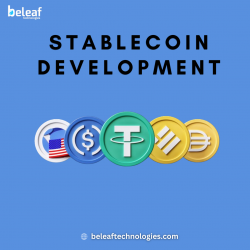Stablecoin development
The Evolution of Stablecoin Development
Introduction :-
Stablecoins, an essential innovation in the cryptocurrency world, have emerged as a solution to the price volatility that plagues traditional cryptocurrencies. In this comprehensive article, we will delve into the historical development of stablecoins, their undeniable importance in the crypto world, and the intriguing prospects that lie ahead, with a special emphasis on the role of Beleaf Technology in shaping this evolution.
Understanding the Need for Stability
The idea of stablecoins was born out of the recognition that the volatility of cryptocurrencies like Bitcoin and Ethereum could hinder their widespread adoption.
Early Innovations:
Tether and the Birth of Stablecoins Tether (USDT), launched in 2014, was the first stablecoin to gain widespread acceptance. It pegged its value to the US dollar and offered a bridge between the fiat and crypto worlds.
advantages to the table:
Mitigating Volatility: Stablecoins offer a safe haven from the wild price swings seen in the crypto market. This makes them attractive to investors and traders looking to minimize risk.
Efficient Transactions:
Stablecoins can be transferred quickly and at a fraction of the cost compared to traditional banking systems. This efficiency is a game-changer for cross-border payments and remittances.
Financial Inclusion:
Stablecoins have the potential to provide financial services to the unbanked and underbanked populations around the world. By allowing individuals to transact and store value in a stable digital currency, they can escape the devaluation risks associated with some local currencies.
Enabling Decentralized Finance (DeFi):
Stablecoins have played a vital role in the growth of DeFi, a revolutionary movement that aims to decentralize traditional financial services. Users can now lend, borrow, and earn interest on their assets in a secure, decentralized environment, thanks to stablecoins.
The Evolution of Stablecoin Types
Stablecoin development has seen various models and approaches emerge:
Fiat-Collateralized Stablecoins: Tether (USDT) and other fiat-collateralized stablecoins are backed by traditional currency reserves. Maintaining transparency and security of these reserves is crucial to maintaining trust.
Crypto-Collateralized Stablecoins:
Projects like MakerDAO’s DAI introduced crypto-collateralized stablecoins. These tokens are backed by a pool of cryptocurrencies and governed by smart contracts to maintain their value.
Algorithmic Stablecoins:
Algorithmic stablecoins like Ampleforth and Terra employ algorithms to adjust their supply based on market demand, rather than relying on collateral assets.
Commodity-Collateralized Stablecoins:
Some stablecoins are tied to real-world assets like gold or real estate, providing a unique form of stability.
Conclusion :-
As the stablecoin development sector advances and confronts the challenges it faces, it holds the potential to revolutionize how we perceive and interact with money, marking not just a bridge between the cryptocurrency and fiat worlds but a glimpse into the future of a more stable, efficient, and inclusive financial system, with Beleaf Technology leading the way.
Reach us :
Whatsapp : +91 80567 86622
Skype : live:.cid.62ff8496d3390349
Telegram : https://t.me/BeleafTech
Mail to : [email protected]
URL : https://www.beleaftechnologies.com/stablecoin-development-company














